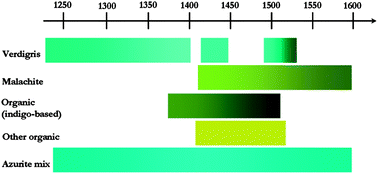This study explores the use of green pigments and mixtures in manuscript illumination, drawing upon experimental evidence derived from a non-invasive spectroscopic survey of green pigments used in 31 bound manuscripts and 23 manuscript cuttings or single folios in the collections of the Fitzwilliam Museum in Cambridge, UK. Analytical investigations were carried out on green-coloured areas by visible and near-infrared fibre optic reflectance spectroscopy (FORS), at times supplemented by X-ray fluorescence (XRF). FORS spectra can easily be acquired in great numbers and without subjecting the manuscripts to any physical strain, making this technique especially suitable for analytical surveys of valuable and fragile objects. Despite some drawbacks, its use in combination with XRF often provides a relatively complete characterisation of pigments and mixtures, particularly when FORS analysis is extended into the shortwave-infrared range (to 2500 nm). The experimental results are examined in light of the recipes for green pigments found in medieval technical treatises. The outcome is a contextualized study with a focus on French illumination between the 13th and the 16th century, but allowing for comparisons with contemporary materials of different geographic origin.

This article is Open Access
 Please wait while we load your content...
Something went wrong. Try again?
Please wait while we load your content...
Something went wrong. Try again?


 Please wait while we load your content...
Please wait while we load your content...